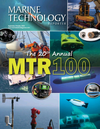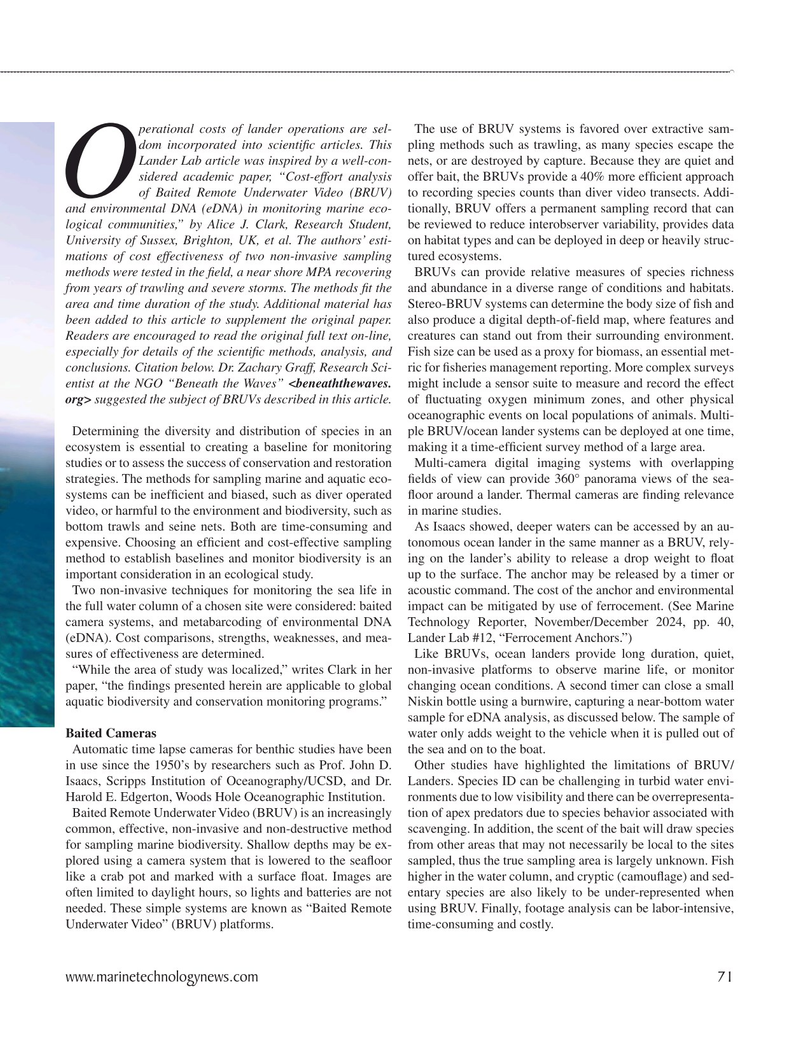
Page 71: of Marine Technology Magazine (September 2025)
Read this page in Pdf, Flash or Html5 edition of September 2025 Marine Technology Magazine
perational costs of lander operations are sel- The use of BRUV systems is favored over extractive sam- dom incorporated into scienti? c articles. This pling methods such as trawling, as many species escape the
Lander Lab article was inspired by a well-con- nets, or are destroyed by capture. Because they are quiet and sidered academic paper, “Cost-effort analysis offer bait, the BRUVs provide a 40% more ef? cient approach
Oof Baited Remote Underwater Video (BRUV) to recording species counts than diver video transects. Addi- and environmental DNA (eDNA) in monitoring marine eco- tionally, BRUV offers a permanent sampling record that can logical communities,” by Alice J. Clark, Research Student, be reviewed to reduce interobserver variability, provides data
University of Sussex, Brighton, UK, et al. The authors’ esti- on habitat types and can be deployed in deep or heavily struc- mations of cost effectiveness of two non-invasive sampling tured ecosystems. methods were tested in the ? eld, a near shore MPA recovering BRUVs can provide relative measures of species richness from years of trawling and severe storms. The methods ? t the and abundance in a diverse range of conditions and habitats. area and time duration of the study. Additional material has Stereo-BRUV systems can determine the body size of ? sh and been added to this article to supplement the original paper. also produce a digital depth-of-? eld map, where features and
Readers are encouraged to read the original full text on-line, creatures can stand out from their surrounding environment. especially for details of the scienti? c methods, analysis, and Fish size can be used as a proxy for biomass, an essential met- conclusions. Citation below. Dr. Zachary Graff, Research Sci- ric for ? sheries management reporting. More complex surveys entist at the NGO “Beneath the Waves”
Determining the diversity and distribution of species in an ple BRUV/ocean lander systems can be deployed at one time, ecosystem is essential to creating a baseline for monitoring making it a time-ef? cient survey method of a large area.
studies or to assess the success of conservation and restoration Multi-camera digital imaging systems with overlapping strategies. The methods for sampling marine and aquatic eco- ? elds of view can provide 360° panorama views of the sea- systems can be inef? cient and biased, such as diver operated ? oor around a lander. Thermal cameras are ? nding relevance video, or harmful to the environment and biodiversity, such as in marine studies.
bottom trawls and seine nets. Both are time-consuming and As Isaacs showed, deeper waters can be accessed by an au- expensive. Choosing an ef? cient and cost-effective sampling tonomous ocean lander in the same manner as a BRUV, rely- method to establish baselines and monitor biodiversity is an ing on the lander’s ability to release a drop weight to ? oat important consideration in an ecological study. up to the surface. The anchor may be released by a timer or
Two non-invasive techniques for monitoring the sea life in acoustic command. The cost of the anchor and environmental the full water column of a chosen site were considered: baited impact can be mitigated by use of ferrocement. (See Marine camera systems, and metabarcoding of environmental DNA Technology Reporter, November/December 2024, pp. 40, (eDNA). Cost comparisons, strengths, weaknesses, and mea- Lander Lab #12, “Ferrocement Anchors.”) sures of effectiveness are determined. Like BRUVs, ocean landers provide long duration, quiet, “While the area of study was localized,” writes Clark in her non-invasive platforms to observe marine life, or monitor paper, “the ? ndings presented herein are applicable to global changing ocean conditions. A second timer can close a small aquatic biodiversity and conservation monitoring programs.” Niskin bottle using a burnwire, capturing a near-bottom water sample for eDNA analysis, as discussed below. The sample of
Baited Cameras water only adds weight to the vehicle when it is pulled out of
Automatic time lapse cameras for benthic studies have been the sea and on to the boat.
in use since the 1950’s by researchers such as Prof. John D. Other studies have highlighted the limitations of BRUV/
Isaacs, Scripps Institution of Oceanography/UCSD, and Dr. Landers. Species ID can be challenging in turbid water envi-
Harold E. Edgerton, Woods Hole Oceanographic Institution. ronments due to low visibility and there can be overrepresenta-
Baited Remote Underwater Video (BRUV) is an increasingly tion of apex predators due to species behavior associated with common, effective, non-invasive and non-destructive method scavenging. In addition, the scent of the bait will draw species for sampling marine biodiversity. Shallow depths may be ex- from other areas that may not necessarily be local to the sites plored using a camera system that is lowered to the sea? oor sampled, thus the true sampling area is largely unknown. Fish like a crab pot and marked with a surface ? oat. Images are higher in the water column, and cryptic (camou? age) and sed- often limited to daylight hours, so lights and batteries are not entary species are also likely to be under-represented when needed. These simple systems are known as “Baited Remote using BRUV. Finally, footage analysis can be labor-intensive,
Underwater Video” (BRUV) platforms. time-consuming and costly.
www.marinetechnologynews.com 71
MTR #7 (66-79).indd 71 MTR #7 (66-79).indd 71 10/8/2025 3:50:52 PM10/8/2025 3:50:52 PM

 70
70

 72
72
